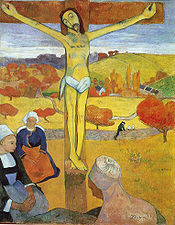
Cloisonnism
Encyclopedia

Post-Impressionism
Post-Impressionism is the term coined by the British artist and art critic Roger Fry in 1910 to describe the development of French art since Manet. Fry used the term when he organized the 1910 exhibition Manet and Post-Impressionism...
painting with bold and flat forms separated by dark contours. The term was coined by critic Edouard Dujardin
Édouard Dujardin
Édouard Dujardin was a French writer, one of the early users of the stream of consciousness literary technique, exemplified by his 1888 novel Les Lauriers sont coupés.-Biography:...
on occasion of the Salon des Indépendants
Société des Artistes Indépendants
—The Société des Artistes Indépendants formed in Paris in summer 1884 choosing the device "No jury nor awards" . Albert Dubois-Pillet, Odilon Redon, Georges Seurat and Paul Signac were among its founders...
, in March 1888. Artists Émile Bernard
Émile Bernard
Émile Henri Bernard is known as a Post-Impressionist painter who had artistic friendships with Van Gogh, Gauguin and Eugene Boch, and at a later time, Cézanne. Most of his notable work was accomplished at a young age, in the years 1886 through 1897. He is also associated with Cloisonnism and...
, Louis Anquetin
Louis Anquetin
Louis Anquetin was a French painter.Anquetin was born in Étrépagny, France and educated at the Lycée Pierre Corneille in Rouen....
, Paul Gauguin
Paul Gauguin
Eugène Henri Paul Gauguin was a leading French Post-Impressionist artist. He was an important figure in the Symbolist movement as a painter, sculptor, print-maker, ceramist, and writer...
, Paul Sérusier
Paul Sérusier
Paul Sérusier was a French painter who was a pioneer of abstract art and an inspiration for the avant-garde Nabi movement, Synthetism and Cloisonnism.- Education :...
, and others started painting in this style in the late 19th century. The name evokes the technique of cloisonné
Cloisonné
Cloisonné is an ancient technique for decorating metalwork objects, in recent centuries using vitreous enamel, and in older periods also inlays of cut gemstones, glass, and other materials. The resulting objects can also be called cloisonné...
, where wires (cloisons or "compartments") are soldered to the body of the piece, filled with powdered glass, and then fired. Many of the same painters also described their works as Synthetism
Synthetism
Synthetism is a term used by post-Impressionist artists like Paul Gauguin, Émile Bernard and Louis Anquetin to distinguish their work from Impressionism. Earlier, Synthetism has been connected to the term Cloisonnism, and later to Symbolism...
a closely related movement.
In The Yellow Christ
The Yellow Christ
The Yellow Christ is a painting executed by Paul Gauguin in autumn 1889 in Pont-Aven. Together with The Green Christ, it is considered to be one of the key-works of Symbolism in painting....
(1889), often cited as a quintessential cloisonnist work, Gauguin reduced the image to areas of single colors separated by heavy black outlines. In such works he paid little attention to classical perspective
Perspective (graphical)
Perspective in the graphic arts, such as drawing, is an approximate representation, on a flat surface , of an image as it is seen by the eye...
and boldly eliminated subtle gradations of color — two of the most characteristic principles of post-Renaissance
Renaissance
The Renaissance was a cultural movement that spanned roughly the 14th to the 17th century, beginning in Italy in the Late Middle Ages and later spreading to the rest of Europe. The term is also used more loosely to refer to the historical era, but since the changes of the Renaissance were not...
painting.
The cloisonnist separation of colors reflects an appreciation for discontinuity that is characteristic of Modernism
Modernism
Modernism, in its broadest definition, is modern thought, character, or practice. More specifically, the term describes the modernist movement, its set of cultural tendencies and array of associated cultural movements, originally arising from wide-scale and far-reaching changes to Western society...
.

